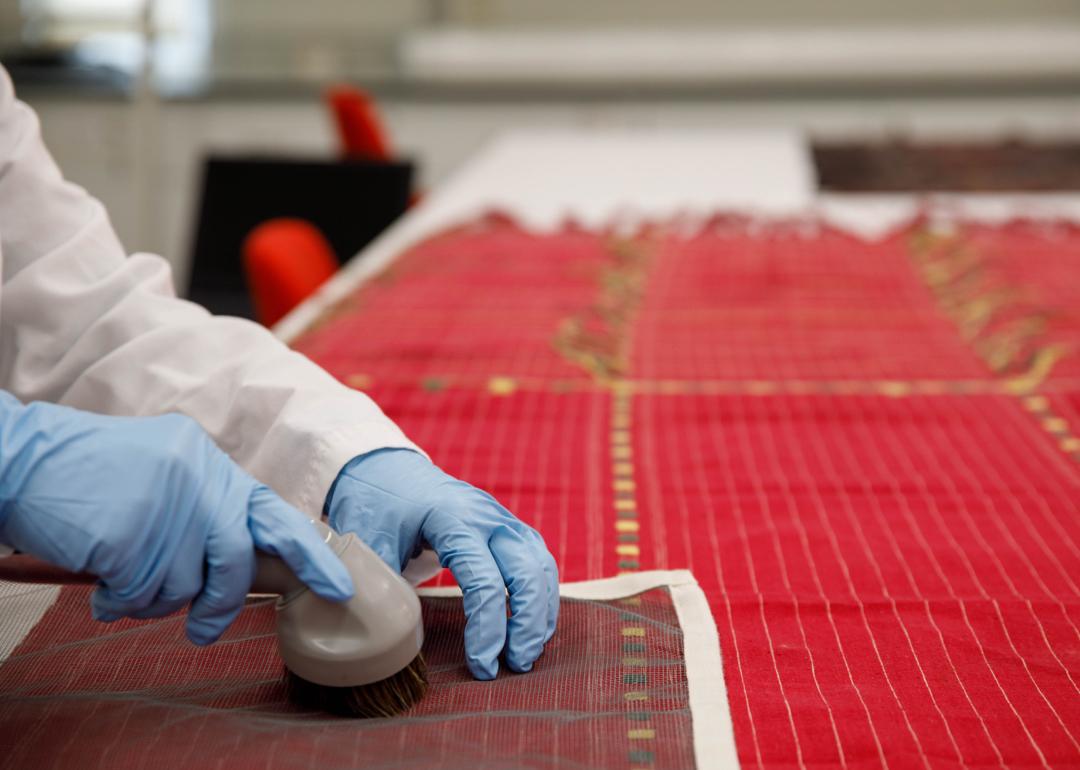Storing Textiles
Many factors should be considered when storing your textiles. These guidelines and videos will help you identify the best location for storing your collection, and the appropriate materials to use.
Storage Location
Store your collection is in a room that is cool, dry and has blinds or curtains that can block natural light. Few of us have the luxury of a spare room that we can devote to storage. Instead we make do with closets, cupboards and space under beds. While it is possible to adapt many spaces in a house for storage, try to avoid attics and basements. These spaces usually do not have climate control and suffer the largest swings of temperature and relative humidity. Learn about light, temperature and humidity control
Once you have selected a location, consider these factors:
- If humidity is high during some part of the year where you live, find some way to circulate the air to avoid mildew problems (even a fan will help). Consider using a dehumidifier to reduce humidity to a more moderate level.
- If humidity is low during some part of the year, consider raising the level of humidity slightly with a humidifier.
- Block windows with shades or blinds.
- Regularly vacuum your storage area(s) to avoid any accumulation of dust and dirt that can attract insects.
- Avoid storing items directly on the floor. Carpet beetles, for example, like to take up residence between the floor and the back of your rug.
Video: How do I safely store my textile(s) at home?
Storage Hardware
If you have space, you can use metal shelving to store your collection. Pad the shelves with a cushioning material (such as polyester felt) so that the edges do not make indentations on your textiles.
If you store your collection in wooden drawers or on wooden shelves, it is important to provide a buffer between the wood acids and your collection. Line the drawers or shelves with acid-free tissue or acid-free barrier paper. This paper lining should absorb excess acids for two or three years before it needs to be changed.
Storing Options
The best way to store many — but not all — textiles is to keep them rolled. If textiles are folded for a long period of time and the folds are not padded to relieve pressure, then creases will form. The pressure exerted on the folded area can weaken the foundation of a textile or, worse, break it if the piece is already brittle. It is best to roll textiles around an archival support tube. Avoid using polyvinyl chloride tubing (PVC pipe) as the roll support: This material gives off damaging chemicals as it breaks down. When rolling is not an option for storing a textile, folded storage can be a suitable alternative, though it is very important to pad the interiors of any fold. Mat storage is an excellent option for smaller, awkwardly sized or more fragile textiles, especially fragments.
Video: What is the best way to store a flat textile?
Video: What is the best way to store a quilt or costume?
Video: Demo of folded storage for a quilt
Video: Demo of folded storage for costume
Video: What is the best way to store a small or fragile textile?
- Rolling 101
-
The overall condition of your textile should determine the rolling method. With rugs, for example, the pile is generally more vulnerable than the foundation, so it is better to roll with the pile inside. However, if the foundation is weaker than the pile, or if a lining has been sewn on the rug, roll with the foundation inside. If a rug is lined, wrinkling will always occur during rolling. In this case, it is best to roll with the lining inside to allow the lining — rather than the rug — to wrinkle. In addition, always roll in the direction of the pile to avoid abrading the pile or placing stress on the knots.
It can be difficult to get started rolling and to keep the rug straight on the tube. To help you get started, use a “leader” of washed cotton sheeting or muslin. The fabric should be a few inches wider than the rug and long enough to wrap completely around the tube once, with about two extra feet to spare. Roll the fabric onto the tube and lay the rug (with the pile direction away from you) on the two-foot extension. As you roll, the fabric will catch the rug and allow you to roll the rug smoothly. Try to keep the warps perpendicular to the tube. If a rug is especially crooked it may be necessary to add a little "ease" to avoid rolling the rug in a spiral. To add ease, move one edge of the tube forward slightly with each revolution so that the warps remain perpendicular to the tube. The resulting roll will be slightly looser than it would be if you were able to roll the rug straight from top to bottom.
If you wrap your rolled rug in a length of muslin or sheeting, this will act as a dust and light barrier. The fabric should be wider than the rug — enough either to be tucked into the ends of the tube or tied down onto the tube to protect the edges of the rug from dust. The fabric cover should be long enough to roll around the rug at least one and a half times to be secure. Just as you started rolling with a leader, place the fabric on the face of the rug just before the end and roll until the fabric covers the rug. Secure the roll with cotton or polyester twill tape. Ties can also be made by tearing muslin or cotton sheeting into two-inch wide strips. It normally takes two or three ties to secure the cover in place and prevent the rug from unrolling. You should plan on washing the covering every six to 12 months to remove accumulated dust and dirt.
Maintaining Storage Areas
Most moth and carpet beetle infestations occur in stored textiles. In some cases, your piece could have been infested before you put it in storage, and the quiet, dark conditions caused the infestation to worsen rapidly.
It is therefore important to have a good housekeeping plan for your storage areas. Once each month, unroll at least one item from the different locations of your storage area(s) to check for evidence of infestation. Choose different items each month. Wipe shelving and shelf padding and, if necessary, wash or replace covers and padding. Thoroughly vacuum the room to eliminate insect-attracting dust. Check baseboards and windowsills for dust as well.
Archival Storage Materials
These trusted providers are an excellent source for the archival materials needed to care for your collection.
Gaylord Archival
P.O. Box 4901
Syracuse, NY 13221-4901
800-448-6160
Light Impressions
2340 Brighton Henrietta Town Line Rd.
Rochester, NY 14623
800-975-6429
University Products
P.O. Box 101
517 Main St.
Holyoke, MA 01041-0101
800-336-4847
Hollinger Metal Edge
9401 Northeast Dr.
Fredericksburg, VA 22408
800-634-0491
TALAS Supplies
330 Morgan Ave.
Brooklyn, NY 11211
212-219-0770







